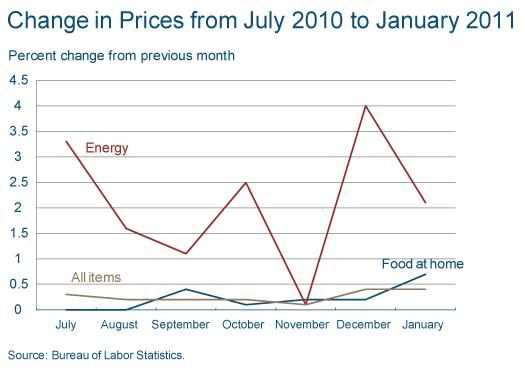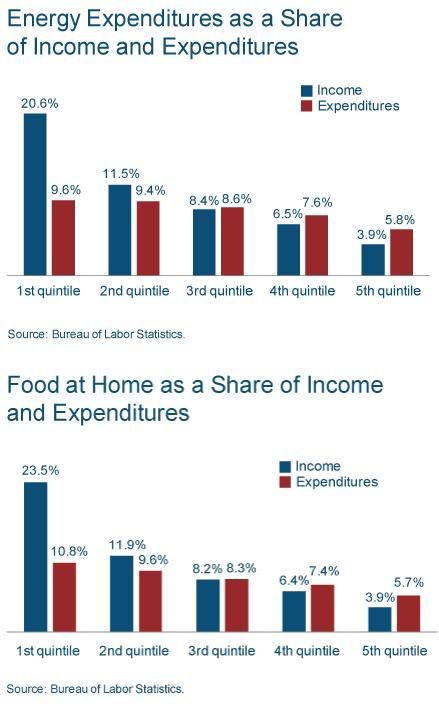To follow up on the post I did yesterday, "How Much Does the Average U.S. Household Spend on Food and Fuel?" the Cleveland Fed has a new report out on the same subject, so I'm adding it today. Of course, defining the "average" American is difficult and makes all of the difference in producing a report showing what percent of food and fuel comes out of a household budget. In yesterday's post, an annual income of $50,000 was used.
K. McDonald
_________________________
Rising food and energy prices have been getting considerable attention recently. The latest report from the Bureau of Labor Statistics (BLS) shows that both of these components of the CPI outpaced the average for the index. Energy rose by 2.1 percent (7.3 percent year-over-year), which is consistent with its longer trend over the past six months. Curiously, given the focus it has received, the rise in food prices has been much more modest, just 0.5 percent (1.8 percent year-over-year). In particular, “food at home,” which excludes changes in the price of dining out, rose by only two-tenths of a percent more than overall food prices (0.3 percent more year-over-year). In fact, food at home is up only 2.7 percent from its lowest point in the past two years. Meanwhile, the CPI rose 0.4 percent in January, implying a 1.6 percent annual increase in the broad measure of prices.

It should not come as a surprise that people are particularly concerned about increases in food and energy prices, whether the increases are large or small. Not only do energy prices pass through to other prices, but household expenditures on food and energy make up a significant fraction of total household expenditures. Data from the BLS Consumer Expenditure Survey show that on average from 1999 to 2009, energy (including motor fuel) and food at home accounted for more than 15 percent of total expenditures and 13 percent of after-tax income.
The importance of food and energy prices to households’ bottom lines is not evenly distributed across the income distribution either. For the median household, food and energy are roughly 17 percent of both expenditures and after-tax income. Households in the top 20 percent of the income distribution spend 11.6 percent of total expenditures on food and energy, which adds up to 7.9 percent of disposable income. For the bottom 20 percent these shares rise to 20.4 percent of expenditures and a whopping 44.1 percent of after-tax income!

For those astutely wondering why food and energy expenditures are a larger fraction of total expenditures than of total income for the bottom 20 percent, there is a much higher fraction of households in this quintile which may be using savings and credit markets to consume above their annual income. Likely categories are the unemployed, business owners with temporary losses, students living on loans, and retirees drawing down their nest eggs.
[source]
K. McDonald
The Cost of Food and Energy across Consumers
by Daniel Carroll
by Daniel Carroll
Rising food and energy prices have been getting considerable attention recently. The latest report from the Bureau of Labor Statistics (BLS) shows that both of these components of the CPI outpaced the average for the index. Energy rose by 2.1 percent (7.3 percent year-over-year), which is consistent with its longer trend over the past six months. Curiously, given the focus it has received, the rise in food prices has been much more modest, just 0.5 percent (1.8 percent year-over-year). In particular, “food at home,” which excludes changes in the price of dining out, rose by only two-tenths of a percent more than overall food prices (0.3 percent more year-over-year). In fact, food at home is up only 2.7 percent from its lowest point in the past two years. Meanwhile, the CPI rose 0.4 percent in January, implying a 1.6 percent annual increase in the broad measure of prices.

It should not come as a surprise that people are particularly concerned about increases in food and energy prices, whether the increases are large or small. Not only do energy prices pass through to other prices, but household expenditures on food and energy make up a significant fraction of total household expenditures. Data from the BLS Consumer Expenditure Survey show that on average from 1999 to 2009, energy (including motor fuel) and food at home accounted for more than 15 percent of total expenditures and 13 percent of after-tax income.
The importance of food and energy prices to households’ bottom lines is not evenly distributed across the income distribution either. For the median household, food and energy are roughly 17 percent of both expenditures and after-tax income. Households in the top 20 percent of the income distribution spend 11.6 percent of total expenditures on food and energy, which adds up to 7.9 percent of disposable income. For the bottom 20 percent these shares rise to 20.4 percent of expenditures and a whopping 44.1 percent of after-tax income!

For those astutely wondering why food and energy expenditures are a larger fraction of total expenditures than of total income for the bottom 20 percent, there is a much higher fraction of households in this quintile which may be using savings and credit markets to consume above their annual income. Likely categories are the unemployed, business owners with temporary losses, students living on loans, and retirees drawing down their nest eggs.
[source]